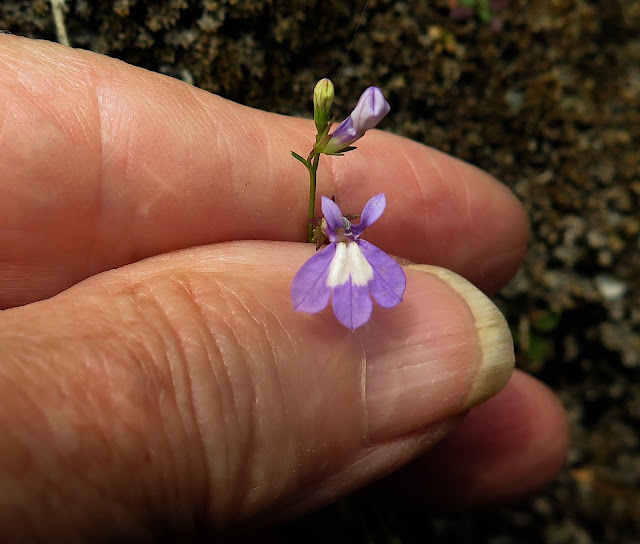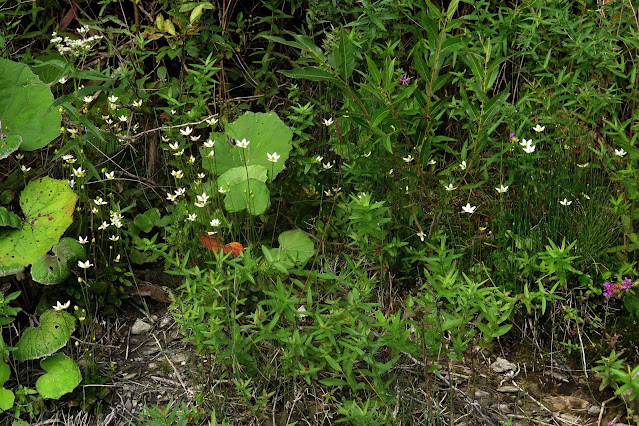For a wildflower seeker like me, it's always exciting to learn of a new site that's rich with native wildflowers. Especially when that site is not far from home, and one I can drive right up to, without trekking through trackless woods or slogging through bogs or breathlessly scrambling up mountains. So when my friend Sue Pierce told me of this site near her home in Hudson Falls, a riverside site near the Boralex Hydropower Dam, with steep shale cliffs that were habitat for some of our favorite wildflowers, I begged her, "Oh please, take me there!" So she did.
I suppose, at first glance, these bare-looking rocks don't appear to be a likely home for unusual native wildflowers. But these aren't just any old rocks. These shale cliffs were built up in ancient geologic times, when most of this part of New York State was covered by a deep sea, and these rocks, consisting of layers upon layers of sea-bottom sediment containing the shells and bones of sea creatures, are rich in the calcareous nutrients some of our more unusual plants require.
These cliffs are not barren and dry, but are constantly watered by dripping springs, springs that carry the dissolved limey nutrients from deep in the earth to the surface of the rock. In some ways, these springs help to create a habitat similar to a rich fen, although on hard rock instead of grassy mud.

Our mutual friend Ruth Brooks (blue shirt) joined Sue and me this past week at these steep shale cliffs, to see what we could find. It looks as if Ruth has found something worth taking a photo of!

Indeed she did! This beautiful native wildflower called Grass of Parnassus (Parnassia glauca) thrives here by the thousands, their snowy-white, faintly-striped flowers shown off to great advantage against the dark spring-watered shale.

Did you notice the small purple flowers off on the right side of the photo above? This is another native wildflower, called Kalm's Lobelia (Lobelia kalmii), that can usually be found in similar lime-rich wet sites as the Grass of Parnassus. Here's a closer look at its pretty purple flowers with a white patch at the throat.
But the star of today's show was the Grass of Parnassus, a flower we thought we wouldn't find this summer. That's because the only other place we have ever seen it -- on spring-watered steep shale cliffs along the Hudson River just upstream from Glens Falls -- cannot be approached by canoe this summer because of a drastic water drawdown to allow for dam repairs. And here was an even more abundant population of this rarely found flower, and one we could walk right up to!
The Grass of Parnassus seemed very happy here, even though it had to share its territory with lots of roadside weeds.
One of those "weeds" was this fruit-laden vine called Bittersweet Nightshade (Solanum dulcamara). This plant is not native to North America, but it does look quite lovely this time of year, when its abundant fruits turn a translucent ruby red.
Here was another "weed," this one sprawling across the crumbled shale at the base of the cliffs, and I did a double-take when I came upon it. I have never seen the stems and flowers of Spotted Spurge (Euphorbia maculata) so beautifully rosy. Perhaps the geology has affected the botany in this case. I know that lots of folks consider this as just another no'count sidewalk weed, but it is a native wildflower, and a very generous one, too. It will happily and quickly cover any patch of bare dirt, and thus it helps to keep the alien invasive weeds at bay
Here's that Kalm's Lobelia again, only this time sporting a few flowers that are white instead of purple. Joining this Lobelia patch was another native wildflower with much bigger and more deeply colored flowers. This is Slender Gerardia (Agalinis tenuifolia). And there were many more of these around.
Many, many more!
Sue and Ruth and I followed the road around until it ended at the human structure supporting the dam operations. This particular shale cliff supported few showy flowers, but it did have many interesting mosses, lichens, and liverworts plastered tight to its dampened rock. This gave our bryophyte-savvy friend Ruth some puzzles to ponder and finds to delight in.
Here's one of the more photogenic of the mosses we found on this cliff, a sprightly clump of Fountain Moss (Philonotis fontana). As its name suggests, this moss grows only where the substrate is frankly wet, and this photo makes it obvious how wet the surface of the rock truly was.
And here's the Boralex Hydropower Dam, dominating the site of the Hudson River waterfall that suggested the name of this town of Hudson Falls. The natural waterfall that is visible in the foreground is actually called Baker's Falls, named for an 18th Century resident of this village. I imagine the original waterfall was quite spectacular, before the hydroelectric dam was built.
The view of the Hudson River below the dam remains quite spectacular, with forested banks and high shale cliffs along the shore. From here, the Hudson flows nearly due south to the sea, although it still tumbles through rapids from here to Troy. At Troy, the Hudson levels off and even becomes tidal, growing more and more brackish as it approaches the Atlantic Ocean at New York City. As I look out over this wild-looking (although dam-tamed) river, I'm struck by its beauty as well as reminded of its long history, both human and geological. There are so many stories here. Some of them preserved in these rocks.















2 comments:
Those plants do sound like a fen up here.
Jackie,
Wonderful entry! I enjoyed it very much - so much so that I was inspired to find my way to this site yesterday to see these wonderful flowers - especially the Grass of Parnassus.
Your caption for the second-to-last photo in this series reads, in part, "The natural waterfall that is visible in the foreground is actually called Baker's Falls, named for an 18th Century resident of this village. I imagine the original waterfall was quite spectacular, before the hydroelectric dam was built."
In response to that, I thought you might enjoy this entry from the journal of Charles Carroll of Carrollton, during his visit to Canada, in 1776, as one of the Commissioners from Congress. Carroll, his cousin John Carroll (founder of Georgetown University), and fellow signers of the Declaration of Independence, Benjamin Franklin and Samuel Chase accompanied him on that trip up the Hudson, overland from Fort Edward to Lake George, and up Lake Champlain, eventually making their way to Montreal. About this section of the river he writes:
"The country between Wing's tavern and Fort Edward is very sandy and somewhat hilly. The principal wood is pine. At Fort Edward the river Hudson makes a sudden turn to the westward; it soon again resumes its former north course for, at a small distance, we found it on our left and parallel with the road which we travelled, and which, from Fort Edward to Fort George, lies nearly north and south. At three miles, or thereabouts, from Fort Edward, is a remarkable fall in the river. We could see it from the road, but not so as to form any judgment of its height. We were informed that it was upwards of thirty feet, and is called the Kingsbury falls. We could distinctly see the spray arising like a vapor or fog from the violence of the fall. The banks of the river, above and below these falls for a mile or two, are remarkably steep and high, and appear to be formed or faced, with a kind of stone very much resembling slate. The banks of the Mohawk's river at the Cohooes are faced with the same sort of stone; – it is said to be an indication of sea-coal."
Cool, eh?
Post a Comment